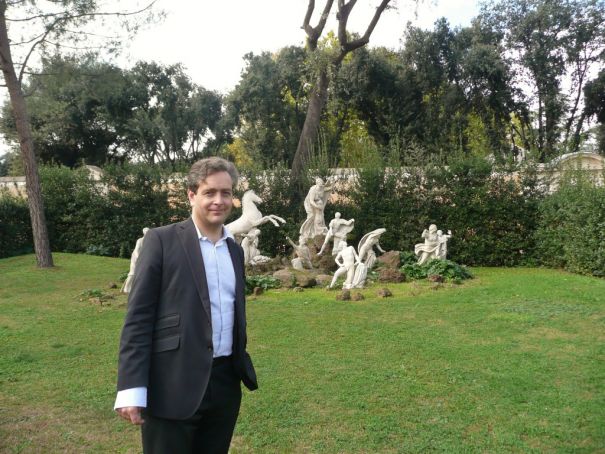Margaret Stenhouse
The French Academy – once considered a rather aloof institution – is undergoing a transformation.
A well-known local legend, trotted out by tour guides, recounts that the eccentric Queen Cristina of Sweden, who converted to Catholicism and came to live in Rome in 1654, fired a cannon ball from Castel S. Angelo at Villa Medici on the Pincio hill above the Spanish Steps. That same cannon ball is said to be the one that now sits on top of the fountain in front of the Villa.
The rather plain and forbidding frontage that Villa Medici presents to the city of Rome may have inspired the queen with fortress-besieging fantasies, hence her provocative gesture, but she would have had a very different impression if she had gone inside. The interior – the private façade, which looks over the gardens – is a show-piece of renaissance pomp and splendour, reflecting the status of Cardinal Ferdinando de’ Medici, who transformed it from a country residence (the area was still quite rural in the 16th century) into a palace intended to dazzle Rome.
According to Éric de Chassey, director of the Académie de France à Rome, which has been housed in the Villa Medici since 1803, the French Academy's reputation as a somewhat closed world is partly due to its outward appearance. “The front is the side that most people see and it is so austere that it is almost forbidding. But that was the way the Medici wanted it. The show of wealth and power was reserved for themselves and the guests they wanted to impress.”
Once inside the entrance hall, a flight of stairs leads up to the loggia which gives onto the gardens. This was the fulcrum of the villa, where 16th-century visitors would gasp in admiration at the vision opening before them – the sweeping balustrades flanked by two sculpted lions (one ancient, the other a 17th-century copy), the Giambologna bronze statue of Mercury hovering over the fountain basin, and the vast renaissance garden, with its hedged walks lined with ancient marbles and a “wild wood”, where the cardinal could indulge in a bit of hunting.
The cardinal lived in the villa for 11 years. He had expected to become pope, but the death of his older brother took him back to Florence to rule the Medici empire instead. When he departed he took most of his sculpture collection with him, including the lions and the Mercury, but fortunately he was unable to strip off the innumerable ancient Roman bas-reliefs, including some fragments from the Ara Pacis, with which he had decorated the interior façade. These are still there today.
Appointed director in 2009, Eric de Chassey has embarked on a sweeping renovation programme. This has included major restoration projects and cultural initiatives aimed at revolutionising the academy's historically staid and aloof image. He believes that it is vitally important for the French Academy to “open up more to the world”.

Thanks to this, the gardens are now open daily to guided tours in English, French and Italian. The tour includes the newly-restored Cardinal Ferdinando's Pavilion, with its charming “Room of the Birds”. Decorated by Jacopo Zucchi, this features a veritable encyclopaedia of fauna covering the walls and ceiling. The adjoining “Room of Aurora” is a riot of grotesques and frescoed medallions depicting the villa during various phases of construction. A discreet little staircase leads from the pavilion down to the present Viale del Muro Torto, which in Medici time would have been outside the city. No-one knows for sure, but it is suspected that the pavilion may have been the cardinal's secret love nest.
The visit also includes the atelier with the Academy’s collection of plaster casts made by the borsisti (scholarship winners) dating back to the 17th century. The Academy was originally founded in 1666 by the Sun King, Louis XIV, to give young French artists the opportunity to study classical Roman masterpieces. However, they were also expected to supply the king with copies to decorate his palace in France. Originally thought worthless, these casts are now seen as valuable historic evidence of the work carried out by the students.
The Niobe sculpture group, based on an ancient Greek myth, is a focal point of the garden. This was one of the jewels of the cardinal's collection. Unfortunately, it also went with him to Florence. However the celebrated French artist Balthus, who was director of the Academy between 1961-1977, had copies made and visitors never fail to be moved by the sight of the agonising bodies of Niobe's dying children, scattered around the lawn in a remote corner of the grounds.
The fortunate borsisti, elected each year by a Paris commission, spend two or three years in Rome living at the Villa Medici. They do not necessarily have to be French, de Chassey says, and the Academy is no longer confined to painting and sculpture but is open to other disciplines, such as art history, photography, cinema, literature, design, choreography and even the culinary arts.
De Chassey's next project is expected to make a big impact on the Rome exhibition circuit. Planned for the end of this year, it will feature the works of major French, Flemish and Italian artists from a wide selection of foreign museums. Bassifondi di Barocco (“Baroque Low Life”) will centre on the 17th-century underworld, revealing the little-known dark side of a period known for its splendour.
Tours of Villa Medici gardens every day except Monday. Tours of the gardens plus the historic “Director's Apartments” on Wed only. Hours vary. For information tel. 066761223 or consult website.
This article was published in the 3 April 2013 edition of Wanted in Rome magazine.





















